
On the occasion of the 40th anniversary of the Künstlerhaus, the current studio community invites members from the eventful history of the house to present current works. As a continuation of the popular series with artists from the city and the region, GO:40 presents a lively and comprehensive overview of current productions that originated or were further developed in the house at some point. Geographically, the twenty invited artists span from Amsterdam to Dortmund and North Rhine-Westphalia, Kiel, Leipzig, Berlin, Biel in Switzerland and Tokyo, and their subjects and media are just as wide-ranging. The spectrum of works presented ranges from drawings and paintings to photography, film and installations.
The anniversary offers the opportunity to familiarise the new management, which takes office on 1.4.2023, with the history of the house: The history of the Künstlerhaus is one of personalities who, in addition to their own work, have always been active for the programme of the house as curators. When they now come into view with their own works, it becomes clear that the construction of the artist-curated exhibition and residency house is a success story of artists who, contrary to a widespread prejudice, have cooperated and committed themselves to the common good. The City of Dortmund has supported this through continuous funding. The anniversary is a grateful look back and equally a look forward to further years full of programme, surprises and discoveries.



Tomomi Adachi is a performer/composer, sound poet, instrument builder and visual artist. Known for his versatile style, he has performed his own voice and electronics pieces, sound poetry, improvised music and contemporary music, also presented site-specific compositions, compositions for classical ensembles, choir pieces for untrained musicians in all over the world including Tate Modern, Maerzmusik, Hamburger Bahnhof Museum, Centre Pompidou, Poesiefestival Berlin and Walker Art Center.
He has been working with a wide range of materials; self-made physical interfaces and instruments, artificial intelligence, brainwave, artificial satellite, twitter texts, fracture and even paranormal phenomena. He was a guest of the Artists-in-Berlin Program of the DAAD for 2012. He received the Award of Distinction from Ars Electronica 2019. He composed the world's first opera which adopted a libretto written by an artificial intelligence, for which he won the Keizo Saji Prize in 2022.

How much can nature be abstracted? Is it possible to achieve naturalness without an object? Should subjective decisions then be avoided whenever possible? Should regularity be thematized, or should one celebrate confusion? Shall the paint be left to the gravitational force, or does the artist develop strategies for circular processes? My favorite answer would probably be "Both and," and, "One thing at a time." Since after all, I do not place the various pictorial elements next to each other compositionally, I use to layer them successively in levels instead. Each layer consists of a single working step, which in principle affects the entire format all-over - sometimes as a monochrome glaze, sometimes as a network of informal flow traces, and again and again as some precisely constructed endless rays (loops).
In the paintings up to 2016, a multitude of juxtaposed nuances created blurriness. Thus the previously precisely calculated surfaces were de-bounded, and the computer-like aspects were transferred into an anti-subjective kind of brush-based painting. In the current works, a shimmering surface emphasizes the events hidden beneath. The succession of hypotheses and uncertainties accumulate in a relief. Thus the visibility of the final lines on top depends strongly on the direction of light and viewing. Essential for the picture is what ephemerally (literally vorübergehend) appears in it. Loop, blur, and overlookability serve to represent metaphysical considerations of what - going beyond nature - might be an immaterial universe without words.
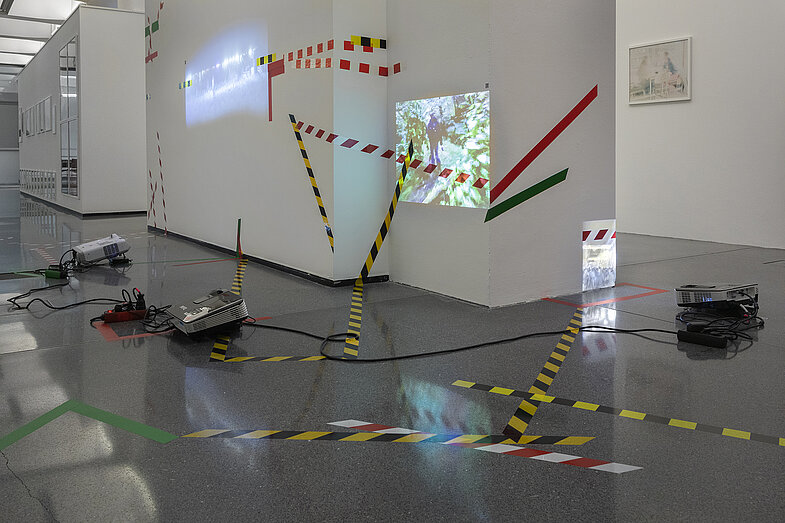
"Borchers’ drawings are images of fragmentary reality experiences, which cannot possibly be conveyed in a simple, centrally located narrative anymore. We stand in front of the picture like we might in a Japanese Zen-garden, and are not able to perceive the totality of the composition, the exact number of the stones on the gravel bed; wherever we stand, the overall image is incomplete." (Jan-Philipp Fruehsorge)
Patrick Borchers is a drawer and video artist. He lives and works in Hagen and Dortmund. After studying art and special education at the University of Dortmund, he attended the class of Timm Ulrichs at the Kunstakademie Münster. His works have been shown in numerous exhibitions in Germany and abroad, for example in Kyoto and Osaka (JP) in 2008, at OK Offenes Kulturhaus OÖ in Linz in 2011, in two exhibitions at Museum Folkwang Essen in 2014, at Neuer Kunstverein Gießen in 2017, at Osthaus Museum Hagen in 2019 and, among others, at Kunstverein Trier Junge Kunst e.V. or at Meno Parkas Gallery, Kaunas (LT) in 2021. In 2022, for example, Borchers realized a volumetric temporary drawing in the Olympiapark Munich and showed large-format drawings at the Verein für Original-Radierung München e.V..

The drawings are mostly watercolours on A4 paper, which are created since the 80s. Since 1996, the drawings are photographed in blocks and printed as c-prints. These are then assembled into new units of different shapes and sizes for the respective exhibition situation and pasted to walls, window panes, through niches, around corners etc. with wallpaper paste.

"In his latest work, „Prototypes,“ Julian Faulhaber once again gives space to his fascination for the material LDPE. His photographs gather objects from our everyday life environment which are made of polyethylene. Faulhaber pictures the objects frontally or slightly turned into depth, each with the same image size, even though their actual dimensions are quite different. The captions accompanying each panel provide only insufficient information about the scales: In addition to the name of the object, its dimensions and weight are indicated – but without actual units such as centimeters or grams. Faulhaber mainly explores white objects, with black-and-white photography.
You could almost think of a research project here. But a scientific review and description of the object is only invoked, as Faulhaber is after the function of images in the way of describing them. To place the same value on each object in the pictorial space is to make them only comparable to each other; a comparability of the world of art with anything lying outside of it is thus negated.
Faulhaber‘s camera releases the objects into a sphere of their own, giving them equivalence, space and expansion while keeping their shape and form. This is how plastics have changed our world – they have added artificial objects and appearances, sculptural units that are attractive to themsel- ves, but in Faulhaber’s assembly appear as an imagined documentation. The presentation denounces itself, betrays every objectivity and only presents us with new puzzles. Ultimately, the seeming research of the objects proves to be a treatise on the nature of photography between construction and representation.
Julian Faulhaber uses his photographic work to deal with something essential. At the same time, the results are aesthetically fascinating in a surprising way, and in a way that is both inspired by and adapted to the subject. In previous work Faulhaber has approached the essence of space, colors and, in his „Catalogue“ series, with the essence of time. Finally, the present series addresses the essence of things in relation to their image: Prototypes. (Dr. Peter Schmieder)

With her video series ‘Portrait of a Collective Body’ artist Nina Glockner questions how the human body is being determined; e.g. how it relates to the space and architecture that surrounds it, how it interacts with the other, and how external power or discipline affects internal structures - and vice versa. In what respects are these influences visible or legible?
When a singular body raises its voice, we become aware of its personal and public narrative, and how it constitutes a particular relationship towards external structures. Establishing intimate connections and thereafter transmitting the identity of an individual helps to tell stories of imaginable lives, where the subjective can enter the public discourse as a collectively recognizable narrative.

"For Antje Hassinger, who mixes pigments and linseed oil for her painting like the old masters, colour is not only colouring but always also material, a pictorial medium of high material presence. On her picture supports, in small format on cardboard or wood, in large format on canvas, she creates relief-like impasto surfaces, almost rhythmically appearing meshes. With a reduced palette of colours she creates charming surfaces, into which she often introduces gestural-impulsive lineatures. Her abstract formal language aims at elementary statements that can be concretised with the terms earth, light, materiality. It is the deliberate reduction of painterly means with which Hassinger achieves an expression of high formal as well as aesthetic quality in her paintings. Despite her free gestures, her work remains strictly abstract without ossifying into dogmatic formalisms." (Marina Schuster / excerpt)

"Sybille Hassinger shows us a highly multilayered world of colour space, whose elements in their complexly charged and heterogeneous interrelationship between geometrically clear static and dynamic traces of movement, between openness and closedness, etc., result in an enigmatic unity that we - just like in real life/ and this is what makes up its quality - cannot really trace. In order to develop the picture step by step, as Hassinger does, until it finally represents a functioning unity, at least two things are required: on the one hand, a great deal of experience and knowledge of colours and their properties, which can only be achieved through countless experimental attempts and the courage to risk even failure. On the other hand, this presupposes a developed sensitivity for the undefinable aesthetic dimension of the work of art - an aesthetic that has to be created and questioned anew, as it were, with each work - or, as in the case of Sybille Hassinger, who layers colour surfaces and forms in and on top of each other like a collage or montage in order to let a world of colour space appear in the surface." (Prof. Dr. Reinhold Happel)

Haubner confronts binary image systems with the traditional methods of analogue letterpress printing. He is particularly interested in the cross-sections and overarching informational added values that go beyond the sequential arrangement of information in books. In print, he adds an additional dimension to the various grids of his works and in this way creates a stalemate between the information systems. In the print-technical realisation of the codings, objects emerge that point far beyond their generating systems.

The viewer is confronted in a loop with a number of statements and questions, which have been posed by a possibly intelligent, machinic counterpart. The text animation is structured by the reoccurring sentence »This is the first sentence on the screen« that introduces a new set of questions. The video addresses the relation of body and thinking, expectation and authorship, as well as the production of meaning. Discussions of artificially created intelligence played a role during the formation of the work as well. On a formal level the animation is shaped by a red to violet morphing, breathing background, on which single words display to form sentences. Viewers can take the time to and engage with the slow rhythm of the text strings. The animated words remind in form and structure of Michael Snows So is this (1982), and take another, updated route of argument.

Glass is the material with which Tina Jacobs works. Glass is transparent - the artist is fascinated by how light shines through glass. Light is experienced as a source of power, as life-giving energy. Light illuminates, light illuminates us. In addition to emotions, light also has to do with truth. In the design of individual pieces, but also ensembles or installations, Tina Jacobs lets a lively language of forms shine. Light shapes spaces, light is different everywhere, light determines the rhythm - makes us happy and sometimes sad. Can light be lured? Today more light than shadow.

In Sonja Kuprat's extensive series of "cloud pictures" the motifs emerge from the dark to the surface of the picture. Heavenly constellations, cosmic phenomena, horizons and ever new shapes of cloudy formations, which sometimes still make one think of depictions of landscapes and nature, become visible. "The change from abstract, purely gestural technique to realistically worked out elements brings an illusion of reality to life. A supposed reality, like in a dream, present and at the same time unreal. Surrounded by darkness, isolated from all connections, this reality becomes fantastic, detached, floating in the void. An idea of infinity, of unknown spaces, of looking into the afterlife, created solely through painting, that can be felt in these pictures." (Christiane Grathwohl-‐Scheffel)

Urban landscapes, urban space, undefined places are the photographic bases of the series "Paisajes". The object "window", as a framing of the view, is to be understood in a broader sense and is used as a metaphor. The interface and the interplay between interior and exterior allow a visuality that is not linear and chronological. The overlapping of image levels as well as the contrast of materiality and the graphic representation create an ambivalence between the recognizable and the undefined in the series of images "Paisajes".
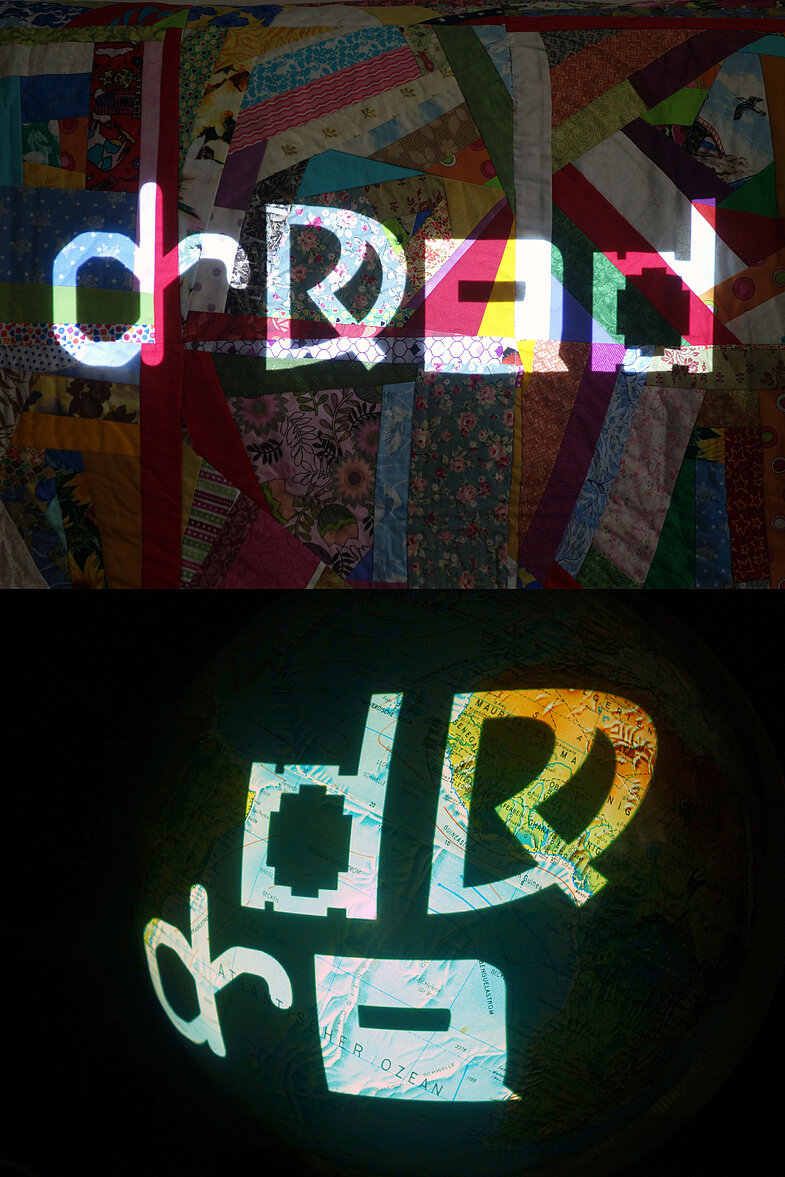
In writing, the opposed positions of the colonizer/colonized binary are distinguished merely by their end letters, “r” and “d.” Merging them visualizes the observation that the affairs of colonizers and colonized are necessarily intertwined, overlapping, and interdependent (Edward Said, Culture and Imperialism, 1994). Other active/passive-tense binaries for which both the minimal written distinction and Said's argument hold are exploiter/exploited, offender/offended, and also the allegedly benign lover/loved. The work aims to raise awareness for contexts conceived through opposing active/passive-tense pairs and challenges the possibility of clear categorizing in general and binaries in particular. In doing so, it commends concepts like ambivalence, hybridity, and undecidables that stand for the evasion of clear demarcations and divides. The graphics were created by digitally blending the letters “r” and “d” in different fonts. Projecting them onto a globe and onto a quilt are metaphors for the pervasiveness of “r/d affairs” in global and local contexts, public and domestic spheres. The distortion and texturing of the projected graphics visualize the dependence of the actualizations of a universalized r/d concept on the time and site-specific circumstances.
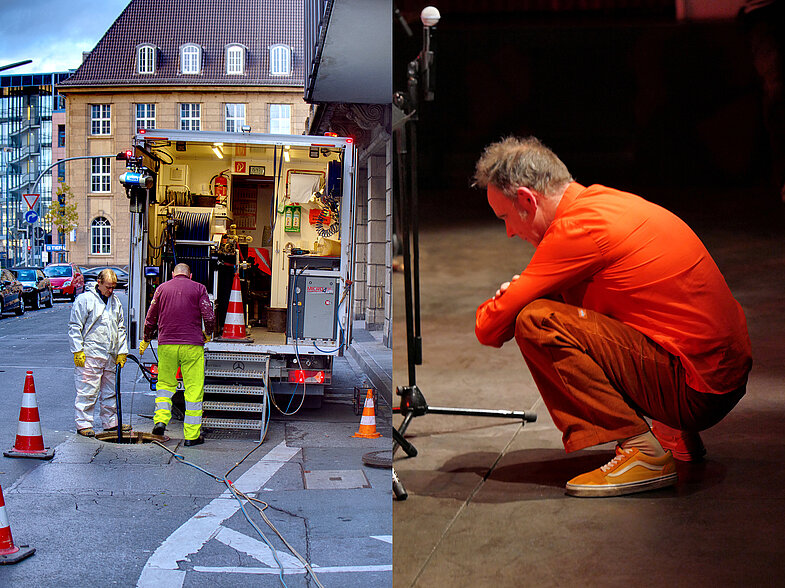
Photography has become so commonplace that nowadays everyone seems to be able to take a “great” picture. The cameras take pictures almost by themselves - artificial intelligence perfects pretty much all steps of "quality formation" and even a lack of imagination can be easily substituted by the appropriate algorithm. So do we still need something as antiquated as an artist “by the grace of God”? I don't believe it. After all, there is no general mandate ... e.g. for "mankind" ... or the "art worshipers" ... it is enough "to sweep in front of one's own front door" and to be attentive to the forms, things and life that surrounds one. The camera is my tool for noting down the visual but also philosophical events, like in a diary. I can turn back at any time - tear out pages - think over - paint over. Over time, some entries condense into focal points - others remain individual items. All belong to my cosmos, which I would like to make available to viewers for their own lecture. No instructions are required here, only the request to take a closer look at the individual picture and even more at the overall picture - just like with all things in everyday life, society and politics!

During Corona times An Seebach opened her site-specific outdoor restaurant at the site of the historical village inn at Jamlitz. Left-overs of the former tavern were reanimated in a popular way. She transformed the historical dump into a raised bed by planting vegetables and herbs, the stump of a tree in the former garden was crowned again – borrowing from Spreewald folk costumes.
An Seebach calls her artistic strategy site-specific action. The artist approaches each exhibition space – seldom an art space, more often an everyday space – especially careful. Through the artistic intervention the space can be structurally read by the visitors and its narrative dimension appears.
The exhibition contribution of An Seebach is supported by NEUSTARTplus of Stiftung Kunstfonds / NEUSTART KULTUR (BKM).
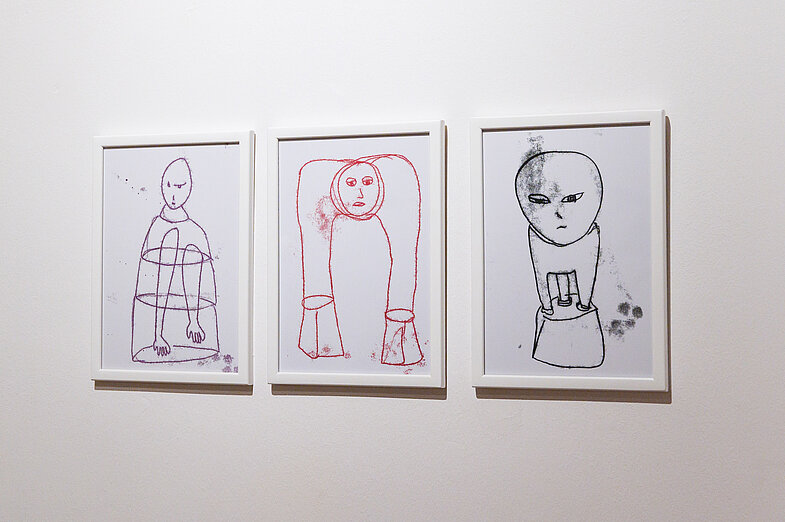
Strange beings and things enter the stage, populate the walls. And like on a stage, the figures are a counterpart to us, near and far, strange and familiar. Like sensitive exponents of co-period, they express something that is (still) in the unconscious. What we see refers - also - to the formless, to the off of every representation. Hildegard Skowasch's figures are staged as something coming into the picture from somewhere and brought to emotional fullness, which also captures the moment of turnover, the crossing over a threshold. The imagination continues to spin the scenes, the encounters, the polyphonic, rich conversation that prevails among the figures. In the seeing, an other-seeing happens. In this showroom, there is always an allusion to another, invisible space, from which the figures first detach themselves in order to stage a mobilizing event through their entry. What is at stake here is the imagery itself, its evolving imagination, its wildness and freedom. Hildegard Skowasch confidently processes different influences of art history. Pop Art, animated Minimalism, Art brut and a subversive Surrealism enter into unpredictable liaisons here. Here, the high and the low, the great and the inane, the wise and the naïve approach each other, join forces, become engaged, and connect. (Dorothée Bauerle-Willert, excerpt from the catalog IRRGAST in Martha ́s Garden, BWA Galeria Sztuki in Olsztyn, Polen 2022)

The homegrown tomato turns out to be very photogenic and ambivalent in its visual meaning. Enhanced by the transformation from photography to serigraphy, this object becomes
this object becomes a creature from the microcosm. The tomato, actually a plant from the mesocosm, suddenly oscillates between microcosm and macrocosm. Garlic and carrot move in the same spheres and confuse our perception.
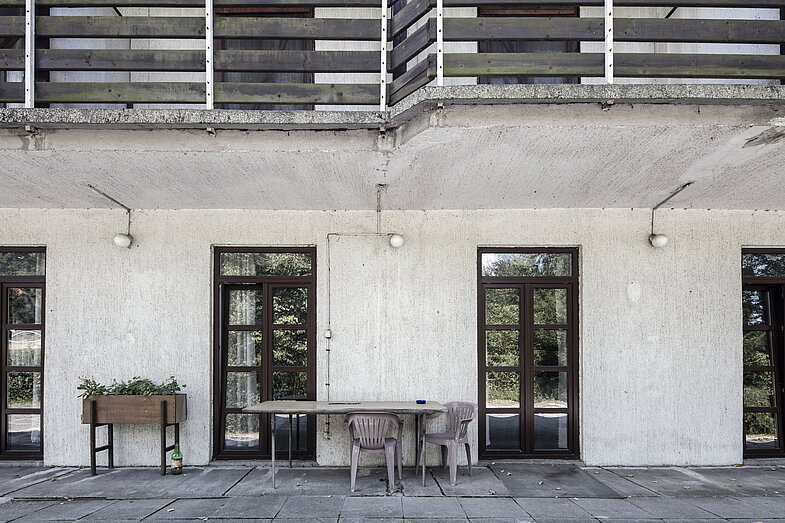
"Silent Witnesses", a representative inventory, is a photographic work on the topic of sexualised war violence in Bosnia and Herzegovina. The work focuses on buildings where war crimes/rape were committed against women of all ethnicities living in Bosnia and Herzegovina. It is about searching for traces and taking stock by photographing the buildings, places of wartime rape, a representative number of which are to be displayed. The buildings where the crimes were committed are scattered in all regions of the state. They carry the history and became places of war crimes, registered in the court records of ICTY and Bosnian courts. Many buildings look fresh, newly painted, renovated. All traces of the past renovated away, so to speak - while the conflict continues to simmer. Some stand empty, branded by what has happened, with no evidence of the crimes committed there. The photographic focus creates new spaces for reflection on the invisibility and simultaneous existence of war crimes committed.

The sculpture "4kant 2023", resting on a base area of 200 cm x 160 cm (78 ¾” x 63”), defines an upwardly open space in the form of a cubiod whose four vertical sides are tectonically joined from layers of oiled, dark, thermal ash. The different lengths and heights of the timbers create openings that vary in size, shape, and position.
The work addresses the ambivalence between a closed and open form. Seen from a distance, the body dominates the space with its massive, static presence. When approaching and walking around the sculpture, the dark austerity of exterior surfaces appear broken by the irregular openings, which partially reveal the view into the interior, and unfold – depending on the perspective – an interplay of light and dark, of light and shadow, whereby the openings onto the interior enclose the light in varying geometric shapes.

Anke Zürn investigates the materials of art, their (hi)stories and possible meanings in different contexts. She is interested in topics such as emotional values of materials, raw materials and raw material deposits. Currently she is working on projects related to indigo, historical lacquer dyes, plant-based colors, and historical inks, such as the iron gall ink.(...) Although inspired by scientific illustrations and historical photographs, Zürn's paintings do not depict any concrete existing species. She is interested in the form creation process itself, the morphogenesis, its dependence on the given materials, while questioning repeatability, replication and uniqueness. In Paris, she created several series within the overarching working title ON GROWTH AND FORM. Through the title, she directly relates her work to the treatise of the same name by mathematician and biologist D'Arcy Wentworth Thompson (1860 - 1948) a treatise on the influence of mathematics and physics for the forms and structures of living beings. The study of physical and chemical properties of water-based painting materials, on the other hand, are indirect reference to Friedlieb Ferdinand Runge (1794 - 1867).